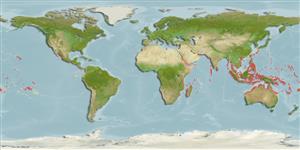Environment: milieu / climate zone / depth range / distribution range
Ecologia
marinhas associadas(os) a recifes; intervalo de profundidade 0 - 3 m (Ref. 30874). Tropical; 32°N - 28°S
Indo-Pacific: Laccadive Islands and Maldives to Mangaréva, Gambier Islands. Western Central Pacific: Guam (Ref. 35721).
Tamanho / Peso / Idade
Maturity: Lm ? range ? - ? cm
Max length : 15.0 cm TL macho/indeterminado; (Ref. 48636)
Espinhos dorsais (total): 13 - 14; Raios dorsais (total): 225; Espinhos anais 2; Raios anais : 23 - 25. Color dusky, greenish with dusky lines. Males with crest and dorsal with alternate dark and pale oblique lines (Ref. 48636). Living specimens may exhibit a complex facial pattern similar to, but not quite as intricate as, that of Entomacrodus niuafoouensis, and barely discernable parallel pinstripes on their sides.
Facultative air-breathing (Ref. 126274); Adults occur in the intertidal zone of rocky shores, rocky reef flats (Ref. 9710), including rock pools, harbors and mangrove zones (Ref. 48636). They graze algae on rocks by groups (Ref. 90102). Oviparous. Eggs are demersal and adhesive (Ref. 205), and are attached to the substrate via a filamentous, adhesive pad or pedestal (Ref. 94114). Larvae are planktonic, often found in shallow, coastal waters (Ref. 94114).
Ciclo de vida ou comportamento de acasalamento
Maturidade | Reprodução | Desova | Ovos | Fecundidade | Larvas
Oviparous, distinct pairing (Ref. 205).
Springer, V.G. and J.T. Williams, 1994. The Indo-West Pacific blenniid fish genus Istiblennius reappraised: a revision of Istiblennius, Blenniella, and Paralticus, new genus. Smithson. Contrib. Zool. 565:1-193. (Ref. 9962)
Status na Lista Vermelha da UICN (Ref. 130435)
Ameaça para os humanos
Harmless
Uso pelos humanos
Pescarias: sem interesse; Aquário: Espécies comerciais
Mais informação
ReferênciasAquaculturaPerfil para aquaculturaEstirpesGenéticaElectrophoresesHereditariedadeDoençasProcessamentoNutrientsConversão de massa
ColaboradoresFotosStamps, Coins Misc.SonsCiguateraVelocidadeTipo de nataçãoÁrea branquialOtólitosCérebrosVisão
Ferramentas
Relatórios especiais
Baixar XML
Fontes da internet
Estimates based on models
Preferred temperature (Ref.
123201): 25.2 - 29.3, mean 28.5 °C (based on 2835 cells).
Índice de diversidade filogenética (Ref.
82804): PD
50 = 0.5001 [Uniqueness, from 0.5 = low to 2.0 = high].
Bayesian length-weight: a=0.00741 (0.00335 - 0.01640), b=3.02 (2.83 - 3.21), in cm total length, based on LWR estimates for this (Sub)family-body shape (Ref.
93245).
Nível Trófico (Ref.
69278): 2.0 ±0.00 se; based on food items.
Resiliência (Ref.
120179): Elevada, tempo mínimo de duplicação da população menor que 15 meses (Preliminary K or Fecundity.).
Fishing Vulnerability (Ref.
59153): Low vulnerability (10 of 100).
Nutrients (Ref.
124155): Calcium = 128 [62, 228] mg/100g; Iron = 0.763 [0.417, 1.358] mg/100g; Protein = 18 [17, 19] %; Omega3 = 0.0659 [, ] g/100g; Selenium = 18.1 [8.4, 42.4] μg/100g; VitaminA = 104 [24, 439] μg/100g; Zinc = 2.41 [1.55, 3.58] mg/100g (wet weight);
